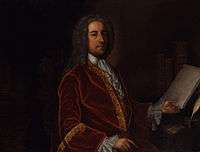William Stanhope, 1st Earl of Harrington
| The Right Honourable The Earl of Harrington PC | |
|---|---|
|
William Stanhope, 1st Earl of Harrington (Godfrey Kneller, 1646-1723) | |
| Lord Lieutenant of Ireland | |
|
In office 15 November 1746 – 15 December 1750 | |
| Monarch | George II |
| Preceded by | The Earl of Chesterfield |
| Succeeded by | The Duke of Dorset |
| Lord President of the Council | |
|
In office 13 February 1742 – 3 January 1745 | |
| Monarch | George II |
| Prime Minister |
The Earl of Wilmington Henry Pelham |
| Preceded by | The Earl of Wilmington |
| Succeeded by | The Duke of Dorset |
| Personal details | |
| Born |
William Stanhope c.1690 |
| Died |
8 December 1756 London, England. |
| Nationality | British |
| Spouse(s) | Anne Griffith (daughter of Colonel Edward Griffith and Elizabeth Lawrence) |
| Parents |
John Stanhope Dorothy Agard |
| Residence | Elvaston Castle |
| Occupation | Peer, British statesman and diplomat. |
General William Stanhope, 1st Earl of Harrington, PC (c.1683 – 8 December 1756) was a British statesman and diplomat.
Biography

He was a younger son of John Stanhope of Elvaston, Derbyshire, and a brother of Charles Stanhope (1673–1760), an active politician during the reign of George I. His ancestor, Sir John Stanhope (d. 1638), was a half-brother of Philip Stanhope, 1st Earl of Chesterfield. Educated at Eton, William Stanhope entered the army and served in Spain during the War of the Spanish Succession as Lieutenant and captain in the 2nd Foot Guards (1703), captain and lieutenant-colonel in the 3rd Foot Guards (1710), colonel of the Regiment of Foot (1711–12), Regiment of Dragoons (1715–18) and the 13th Dragoons (1725–30), Major-General (1735), Lieutenant-General (1739) and General (1747). [1]
He afterwards turned his attention to more peaceful pursuits, went on a mission to Madrid and represented his country at Turin. When peace was made between Britain and Spain in 1720 Stanhope became British ambassador to the latter country, and he retained this position until March 1727, having built up his reputation as a diplomatist during a difficult period. He was appointed Vice-Chamberlain of the Household in 1727–30 and a Privy Councillor on 31 May 1727. In 1729 he had some part in arranging the Treaty of Seville between Britain, France and Spain, and for his services in this matter he was created Baron Harrington in January 1730.
Later in the same year he was appointed Secretary of State for the Northern Department under Sir Robert Walpole, replacing Lord Townshend, but, like George II, he was anxious to assist the emperor Charles VI in his war with France, while Walpole favoured a policy of peace. Although the latter had his way Harrington remained secretary until the great minister's fall in 1742, when he was transferred to the office of Lord President of the Council and was created Earl of Harrington of (Harrington, Northamptonshire) and Viscount Petersham of (Surrey).
In 1744, owing to the influence of his political allies, the Pelhams, he returned to his former post of Secretary of State, but he soon lost the favour of the king, and this was the principal cause why he left office in October 1746. He was Lord Lieutenant of Ireland from 1747 to 1751, and he died in London on 8 December 1756.

in 1741 he was elected a Fellow of the Royal Society. [2]
He had married Anne, the daughter and heiress of Colonel Edward Griffith, and had twin sons:[1]
- William Stanhope, 2nd Earl of Harrington (1719–1779)
- Capt. Hon. Thomas Stanhope (18 December 1719 – 12 January 1743), aide-de-camp to General George Wade
Styles of address
- 1683–1727: Mr William Stanhope
- 1727–1730: The Right Honourable William Stanhope
- 1730–1741: The Right Honourable The Lord Harrington PC
- 1741–1742: The Right Honourable The Lord Harrington PC FRS
- 1742–1756: The Right Honourable The Earl of Harrington PC FRS
References
- 1 2 "STANHOPE, William (c.1683-1756).". History of Parliament Online. Retrieved 11 May 2014.
- ↑ "Fellows Details". Royal Society. Retrieved 11 May 2014.
![]() This article incorporates text from a publication now in the public domain: "Stanhope, William". Dictionary of National Biography. London: Smith, Elder & Co. 1885–1900.
This article incorporates text from a publication now in the public domain: "Stanhope, William". Dictionary of National Biography. London: Smith, Elder & Co. 1885–1900.
![]() This article incorporates text from a publication now in the public domain: Chisholm, Hugh, ed. (1911). "article name needed". Encyclopædia Britannica (11th ed.). Cambridge University Press.
This article incorporates text from a publication now in the public domain: Chisholm, Hugh, ed. (1911). "article name needed". Encyclopædia Britannica (11th ed.). Cambridge University Press.
%2C_Attributed_to_Godfrey_Kneller.jpg)
